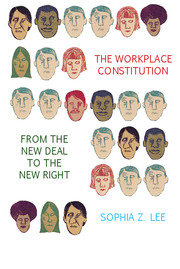Book contents
- Frontmatter
- Contents
- Acknowledgments
- Introduction
- Part I Crafting the Workplace Constitution in the New Deal 1930s and 1940s
- Part II Advancing the Workplace Constitution in the Cold War 1950s
- 4 Liberals Test the Workplace Constitution in the Courts
- 5 Agencies Consider the Liberal Workplace Constitution
- 6 Conservatives Pursue the Workplace Constitution in the Courts
- Part III Administering the Liberal Workplace Constitution in the Long 1960s
- Part IV The Workplace Constitution in the New Right 1970s and 1980s
- Epilogue
- Appendix: Figures
- Notes
- Selected Bibliography of Primary Sources
- Index
4 - Liberals Test the Workplace Constitution in the Courts
Published online by Cambridge University Press: 05 October 2014
- Frontmatter
- Contents
- Acknowledgments
- Introduction
- Part I Crafting the Workplace Constitution in the New Deal 1930s and 1940s
- Part II Advancing the Workplace Constitution in the Cold War 1950s
- 4 Liberals Test the Workplace Constitution in the Courts
- 5 Agencies Consider the Liberal Workplace Constitution
- 6 Conservatives Pursue the Workplace Constitution in the Courts
- Part III Administering the Liberal Workplace Constitution in the Long 1960s
- Part IV The Workplace Constitution in the New Right 1970s and 1980s
- Epilogue
- Appendix: Figures
- Notes
- Selected Bibliography of Primary Sources
- Index
Summary
“If the Fifth Amendment precludes segregation ... in public education, it necessarily precludes segregation ... of Negro firemen.”
Joseph Rauh“To the Colored Firemen ... Employed on the Central of Georgia Railway,” read the notice the Firemen’s Brotherhood posted in the spring of 1953. In 1951, Congress had amended the Railway Labor Act to allow union shops. After overcoming two years of resistance from the railroads, the Firemen’s Brotherhood was about to enforce its new union shop agreement. All eligible firemen would have to join the union or face dismissal. Given the brotherhood’s history of running African Americans off the rails, whether through workplace lynchings or discriminatory agreements, the railway’s black firemen had reason to worry. Many of them had recently asked to join the brotherhood but, as the notice reminded them, the “constitutional requirements of the Brotherhood does [sic] not permit you to become members thereof.” The union shop agreement, the notice nonetheless reassured them, provided that “no employee refused membership in the Brotherhood shall be dismissed.”
Even if the Firemen’s Brotherhood could be trusted, its reassurance no longer sufficed. When the Supreme Court decided the Steele and Tunstall railroad cases in 1944, Charles Houston described the decisions as laying the “ground work” for a future challenge to “the right of the railroad unions to ... [exclude] Negroes from membership.” Houston was felled in 1950 by a heart attack before achieving his ultimate goal. His clients, for their part, remained ambivalent about membership in the brotherhood, reasoning that they would be better off in their independent all-black unions than as a minority in the historically hostile, all-white Firemen’s Brotherhood. A. Philip Randolph did not share their ambivalence, however. Randolph had been committed to fighting for equality from within organized labor since affiliating his Brotherhood of Sleeping Car Porters with the AFL in 1928. During the 1950s, he devoted himself to ending the color bar to union membership.
- Type
- Chapter
- Information
- Publisher: Cambridge University PressPrint publication year: 2014



